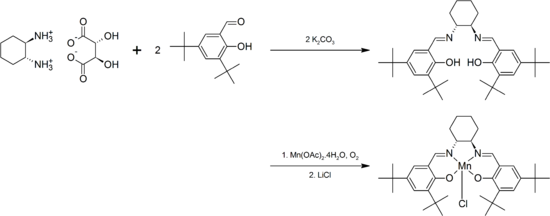- Metal salen complexes
-
Salens are a class of organic compounds used as ligands in coordination chemistry. This class of compounds are named after the simplest example, N,N'-bis(salicylidene)ethylenediamine, more commonly referred to as salen.
Contents
Preparation
Salen ligands are Schiff bases, usually prepared by the condensation of a salicylaldehyde with an amine. For example, the preparation of salen:[1]
The reactants are in principle in equilibrium with the product, and water may be removed via an added drying agent or by azeotropic distillation.[2] In practice, the reaction of the salicylaldehyde with the amine in alcoholic solvent usually goes to completion.
Coordination complexes
In 1938, Tsumaki reported that the cobalt(II) complex Co(salen) reversibly bound O2, which led to intensive research on cobalt complexes of salen and related ligands for their capacity for oxygen storage and transport, looking for potential synthetic oxygen carriers.[3] SalenH2 forms complexes with most transition metals. In many cases, a square pyramidal complex with composition M(salen)L or an octahedral coordination sphere with stoichiometry M(salen)L2 is formed. Illustrative examples include VO(salen) and Co(salen)Cl(py). With d8 metal ions, low-spin square planar complexes form, such as Ni(salen).
Salen complexes are prepared by reacting the diprotic pro-ligand with metal precursors containing built-in bases, such as alkoxides, metal amides, or metal alkyls. The pro-ligand may also be reacted with a metal halide, with or without an added base. Lastly, the pro-ligand may be deprotonated by a non-nucleophilic base, e.g. sodium hydride, before treatment with the metal halide. While alkyllithiums are strong bases, they may react with the imine group, and are thus not appropriate.[2] In this example, Jacobsen's catalyst is prepared from the salen ligand precursor with manganese acetate:[4]
Ligand design
Unsubstituted salen complexes are poorly soluble in organic solvent. The presence of bulky groups near the coordination site is generally desirable, as it enhances catalytic activity and prevents dimerization. Salen ligands derived from 3,5-di-tert-butylsalicylaldehyde are popular because they fulfill both criteria; such complexes tend to be soluble even in non-polar solvents like pentane.
Chirality may be introduced into the ligand either via the diamine backbone, via the phenyl ring, or both.[2] For example, condensation of the C2-symmetric trans-1,2-diaminocyclohexane with 3,5-di-tert-butylsalicylaldehdye gives a ligand that forms complexes with Cr, Mn, Co, Al, which have proven useful for asymmetric transformations. For an example, see the Jacobsen epoxidation.[5]
Salen-type ligands
Numerous types of salen are derived from salicylaldehyde or the diamine.
- The ligand acacen (parent: H2acacen) is derived by condensation of acetylacetone and ethylenediamine.
- The ligand abbreviated "Salph" is derived from the condensation of 1,2-phenylenediamine and salicyaldehyde.
- The ligand "Salqu," derived by condensation of salicylaldehyde and 2-quinoxalinol, is an anionic tetradendate ligand, reminiscent of other macrocyclic ligands. Salqu copper complexes have been investigated as oxidation catalysts.[6]
Salen-type ligands called imino pyridines are also known, and are derived in a similar manner from 2-formylpyridine and a diamine.[7]
Salen-like ligands and complexes
Salan[8] ligands are saturated at the nitrogen; these compounds are amines rather than imines. Salalens are intermediate between salan and salens: one side of the compound bears an imine, while the other side bears a free amine.[9] These complexes tend to be less rigid and more electron rich at the metal center than the corresponding salen complexes. Salan pro-ligands may be synthesized by reduction of salen pro-ligands. They may also be synthesized by the alkylation of an appropriate amine with a phenolic alkyl halide. Like the name suggests, half-salen compounds are not symmetrical. They are prepared from a salicylaldehyde and a monoamine.
References
- ^ Harvey Diehl, Clifford C. Hach (1950). "Bis(N,N' - Disalicylalethylenediamine) -μ - Aquodicobalt(II)". Inorg. Synth.. Inorganic Syntheses 3: 196–201. doi:10.1002/9780470132340.ch53. ISBN 9780470132340.
- ^ a b c Cozzi, Pier Giorgio (2004). "Metal?Salen Schiff base complexes in catalysis: Practical aspects". Chem. Soc. Rev. 33 (7): 410. doi:10.1039/B307853C.
- ^ Tsumaki, T. (1938). "Nebenvalenzringverbindungen. IV. Über einige innerkomplexe Kobaltsalze der Oxyaldimine" (in German). Bull. Chem. Soc. Jap. 13 (2): 252–260. doi:10.1246/bcsj.13.252.
- ^ Larrow, JF; Jacobsen, EN (1998), "(R,R)-N,N'-Bis(3,5-Di-tert-Butylsalicylidene)-1,2-Cyclohexanediamino Manganese(III) Chloride, A Highly Enantioselective Epoxidation Catalyst", Org. Synth. 75: 1, http://www.orgsyn.org/orgsyn/orgsyn/prepContent.asp?prep=v75p0001
- ^ Larrow, J. F.; Jacobsen, E. N. (2004), "(R,R)-N,N'-Bis(3,5-Di-tert-Butylsalicylidene)-1,2-Cyclohexanediamino Manganese(III) Chloride, A Highly Enantioselective Epoxidation Catalyst", Org. Synth., http://www.orgsyn.org/orgsyn/orgsyn/prepContent.asp?prep=V75P0001; Coll. Vol. 10: 96
- ^ Wu, Xianghong, Gorden, A. V. E., (2009). "2-Quinoxalinol Salen Copper Complexes for Oxidation of Aryl Methylenes". Eur. J. Org. Chem. 4: 503–509. doi:10.1002/ejoc.200800928.
- ^ Chatterjeea, D.; Mitraa, A. (2004). "Synthesis, Characterization and reactivities of Schiff-base complexes of Ruthenium(III)". J. Coord. Chem. 57: 175–182. doi:10.1080/00958970410001662435.
- ^ Atwood, David A.; Remington, Michael P.; Rutherford, Drew (1996). "Use of the Salan Ligands to Form Bimetallic Aluminum Complexes". Organometallics 15 (22): 4763. doi:10.1021/om960505r.
- ^ Berkessel, Albrecht; Brandenburg, Marc; Leitterstorf, Eva; Frey, Julia; Lex, Johann; Schäfer, Mathias (2007). "A Practical and Versatile Access to Dihydrosalen (Salalen) Ligands: Highly Enantioselective TitaniumIn Situ Catalysts for Asymmetric Epoxidation with Aqueous Hydrogen Peroxide". Adv. Synth. Catal. 349 (14–15): 2385. doi:10.1002/adsc.200700221.
Categories:- Coordination chemistry
- Metal salen complexes
Wikimedia Foundation. 2010.



